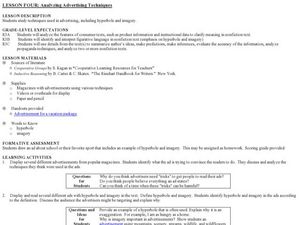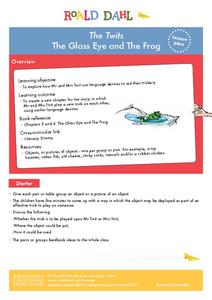Curated OER
Analyzing Advertising Techniques
Students study hyperbole and imagery in advertising. In this advertising techniques lesson, students identify hyperbole and imagery in print advertisements.
Curated OER
I Know Why the Caged Bird Sings
Young scholars examine the use of hyperbole in Maya Angelou's I Know Why the Caged Bird Sings. In this literary analysis activity, students read and discuss chapter 31 from the story. Young scholars write the definition for hyperbole and...
Curated OER
Crazy Critters are Figuratively Fantastic
Eighth graders use creatures created from their imaginations to practice hyperbole, simile, metaphor, and alliteration in association with creative writing. They utilize a worksheet imbedded in this plan to guide their writing.
Curated OER
Comparisons
Fifth graders complete a worksheet. In this comparison lesson, 5th graders view sentences and identify the comparatives in them. Students complete a worksheet on comparisons.
Roald Dahl
The Twits - The Glass Eye and the Frog
What do a pair of stinky socks and a toy hamster have in common? The third lesson in an 11-part unit designed to accompany The Twits by Roald Dahl uses silly objects to teach about figurative language. Zany pranks and role play make...
Curated OER
Knights of the Round Table adapted by Gwen Ross
Everyone loves the tales involving King Arthur and his knights. After reading Knights of the Round Table by Gwen Gross, learners draw inferences and conclusions, analyze story elements, and discuss figurative language, including...
Curated OER
Theater: Create a Script
Figurative language is the focus in the book Teach Us, Amelia Bedelia. After reading Peggy Parish's book, class members dramatize idioms from the text, using dramatic strategies such as characterization, exaggeration, and...
Curated OER
How to Draw Caricatures
Caricature drawing is fun, and can help learners explore the principle of design and content specific vocabulary. They view a video and books that use character drawings, discuss vocabulary such as exaggeration, proportion, and symmetry,...
Curated OER
How I Spent My Summer Vacation
Students hear the story How I Spent My Summer Vacation by Wallace Bleef and share their own summer experiences. They write a tale about one event that happened during their summer using exaggeration.
Curated OER
Yellow Journalism in the Spanish-American War
Students write a newspaper based on events in the year 1898 using Yellow Journalism, the exaggeration of facts or events.
Curated OER
A Picture Speaks A Thousand Words
Students explore the power of images through political cartoons, particularly in light of the Danish caricatures of Muhammad that have incited violence around the world. They create their own original artwork to submit to an appropriate...
Curated OER
The Notorious Hope Diamond: What Makes an American Legend?
Students view and discuss a video on the legend of the Hope Diamond then compare and contrast other tales such as Paul Bunyan, Pecos Bill and Johnny Appleseed. They analyze basic characteristics of these legends then use descriptive...
Curated OER
Short Story 2
Seventh graders review previous reading of Rikki Tikki Tavi. They discuss prior knowledge of simile, metaphor, idiom, and hyperbole. Students practice using vocabulary words from the story by listing synonyms for them. Students read from...
K20 LEARN
Here's How I Heard It: Using Folklore To Improve Close Reading Skills
"X" is for exaggeration, and "F" is for fact. To encourage close reading and to improve literary analysis skills, class members annotate fables and tall tales, like Paul Bunyan, with symbols that identify key features of this genre.
Newseum
Weed Out Propaganda
Young scholars study four essential propaganda techniques: Simplification, Exploitation, Exaggeration, and Division (S.E.E.D.). Individuals select an example of propaganda from the past and present then compare how the key elements have...
Curated OER
Quirky Quatrain Poetry Lesson
Middle schoolers discover what a quatrain is, and are taught the three poetic devices: alliteration, hyperbole, and onomatopoeia. Everyone chooses a favorite hobby or activity, then attempts to write a poem about it. They must write two...
Curated OER
Imagine That! Analyzing Imagery
Poems by O. Henry, Marion Dane Bauer, Monty Roberts, and Langston Hughes provide the text for a study of symbolism, hyperbole, and imagery. Employing the “think-pair-share” strategy learners generate definitions of these terms and locate...
Eastconn
Learning to Analyze Political Cartoons with Lincoln as a Case Study
Discover the five main elements political cartoonists use—symbolism, captioning and labels, analogy, irony, and exaggeration—to convey their point of view.
Curated OER
An Anecdote is Worth a Thousand Pictures
Students identify anecdotes in speeches and the purposes that politicians use the anecdotes for. They create personal anecdotes for the class to hear, and students decide if the anecdote is real or fabricated.
Curated OER
I Know Why the Caged Bird Sings: Chapters 34, 35
Students analyze Maya Angelou's I Know Why the Caged Bird Sings in part of an analysis of imagery. In this Maya Angelou lesson, students read chapters 34 and 35 in the novel and define imager. Students work in pairs to locate two...
Curated OER
Figurative Language 2
Learners read nursery rhymes and advertisements to identify examples of figurative language. As a class, students discuss the use of figurative language and its effectiveness in advertising, children's books, rhymes, poetry, etc. ...
Curated OER
Analyzing Persuasion
A reading of Dr. Martin Luther King Jr.'s "I Have a Dream" speech launches a study of rhetorical devices such as hyperbole, allusion, metaphor, simile, personification, connotative language and parallel structure. Class members then...
National First Ladies' Library
All the News That's Fit to Draw: Political Cartooning and the Presidency
Young scholars research, analyze and study the history of political cartooning in the United States. They recognize a political cartoon, be able to identify the main idea, the symbols and the exaggeration and caricature in political...
Curated OER
Political Cartoons Illustrating Progressivism and the Election of 1912
Students study a current political cartoon to introduce the ideas of symbolism, humor, exaggeration, and caricature in editorial cartoons. They study cartoons from the past to gain an understanding of the culture of 1912.
Other popular searches
- Hyperbole or Exaggeration
- Paul Bunyan and Exaggeration
- Exaggeration of Facts
- Exaggeration and Bias
- Reading Exaggeration
- Exaggerations
- Folktales and Exaggeration
- Tales Exaggeration
- Exaggeration in Nonfiction
- Tall Tale Exaggeration
- Exaggeration Tall Tales
- Exaggeration Lessons























